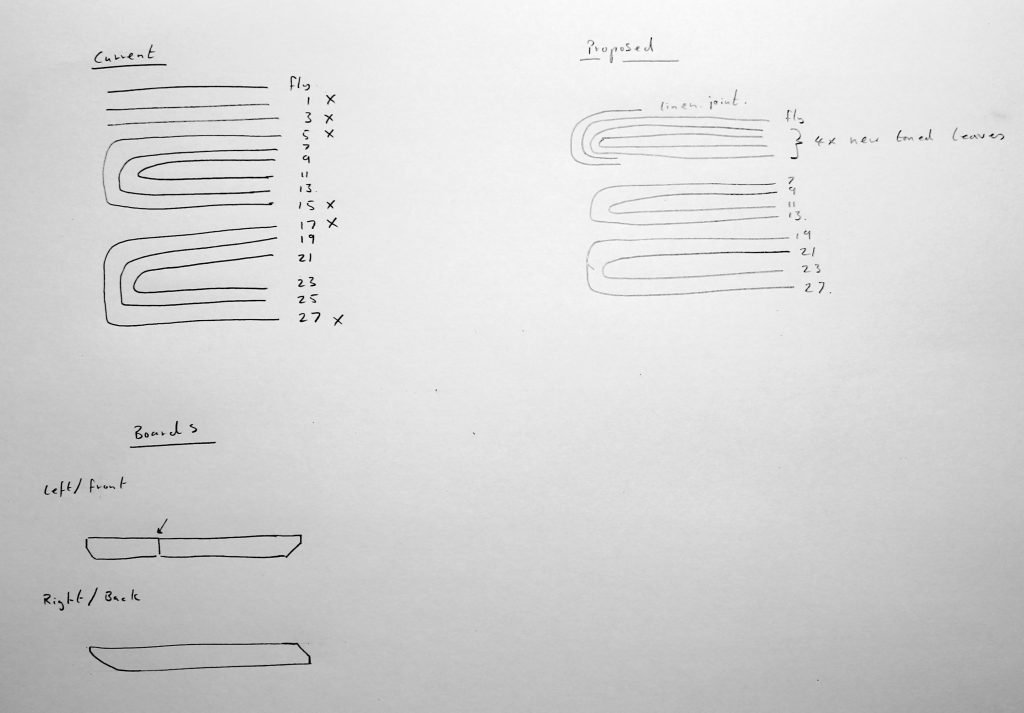
Holinshed’s Chronicles is a 16th Century history of England, Scotland and Ireland; probably best known for its links to William Shakespeare’s history plays, for which it is said to have been a significant resource. It is a large folio of over 1500 pages and this copy was bound between wooden boards covered in calf leather. The book came into my conservation studio in February 2019 and I have been working on it – on and off – for much of the year.
I want to highlight this project for two main reasons, both of which are frequent occurrences within my work: it required many hours of paper repairs; and the book had been worked on multiple times before I received it. I will expand a little on these two points…
Although this project was large, both in its physical stature but also in the time taken, it was fairly typical in the breakdown of how my time is spent; therefore, it is a fairly representative project. In particular, I spent about half the total time on paper repairs and, of that, much of that was spent repairing the spine-folds of each section (over 120 sections in total). This work was absolutely necessary if the book was to be returned to a strong binding sewn on double cord supports.
The Holinshed was a book that had been ‘repaired’ many times before it arrived in my studio: it had been sewn at least three times, and the boards (which were repurposed) were a later addition. This layered binding history is very common for books that I work on, so again is quite representative of the work I take on. Most recently – and perhaps most significantly – it had been worked on by a bookbinder who was unable to complete the project. I am not trying to criticise earlier workmanship, but rather highlight the understanding of binding history which is required, and the essential (though sometimes un-glamorous) work that is key to conserving an early printed book successfully. It is also interesting how one manoeuvres around earlier work: when one decides to preserve old repairs, and when to remove them. I shall let you decided what you think of my efforts!
Although it is pleasing to see the book happily back in its boards and with a handsome hand-tooled red leather label (and I hope that you find the images of these parts of the project interesting), it is really my approach, and the work done to repair the leaves and re-sew the text-block that I think are key to the success of the finished project. I haven’t provided a full written account of the project but have relied on the images and captions, as this is intended to be a blog and not an essay, but I hope that the images here arouse some interest and help to illustrate some of my working practice.
Finally, I would like to thank Simon, from Lyppard books, for keeping an open mind and for permission to use images of his book.















Arthur Green, December 2019

Excellent conservation repair work, very well described. Thank you so much for sharing your ideas and techniques.
Hi Karen, Thanks for the comment, It means a lot from you. x
Hi Arthur
I am Simon’s Dad (Lyppard Books) What a fab Job of ‘Holinshed’ Simon has told me all about it, my interest is that after 41 years as a artefact conservator at the BM I was asked by the Head of Artefact conservation at Camberwell if I would be a visiiting tutor, (that was in 1998-2000 ) stayed at Camberwell until about 2013, But everything changed after Corrine Hillman was replaced by Eve Graves (who was not a conservator)
I look back on my days at Camberwell and loved the place! and have memories of the staff Dave Collins, Mark Sandy, Tony Smith, and others whose names I forget. Its sad they closed the Artefact conservation course, but the Paper post grad course still runs the head of this is a nice New Zealand lady I forget her name! but I got on well with her. All the Best for 2020.
Hi David, Thank your taking the time to comment. I’m glad you found the blog interesting. Simon is great to work for, and this book was a great project: it’s this kind go work that I thrive on!
Yes, very sad news about Camberwell closing its conservation courses, I don’t know how students with limited means get training now? I too have fond memories of my short time at Camberwell.
All the best Arthur
thank you for the photos, the careful process, the immeasurable time, knowledge and steady hand.
Glad you found it useful.
Loved reading the article and the photos are self-explanatory. Well done.
Glad you found it useful.
This is very impressive work. I have spent Christmas afternoon examining each detail of your photographs. Your judgements, precision and skill are wonderful.
Glad you found it useful, thank you for the kind words.
Thank you very much for the explanations and photos. A wonderful work.